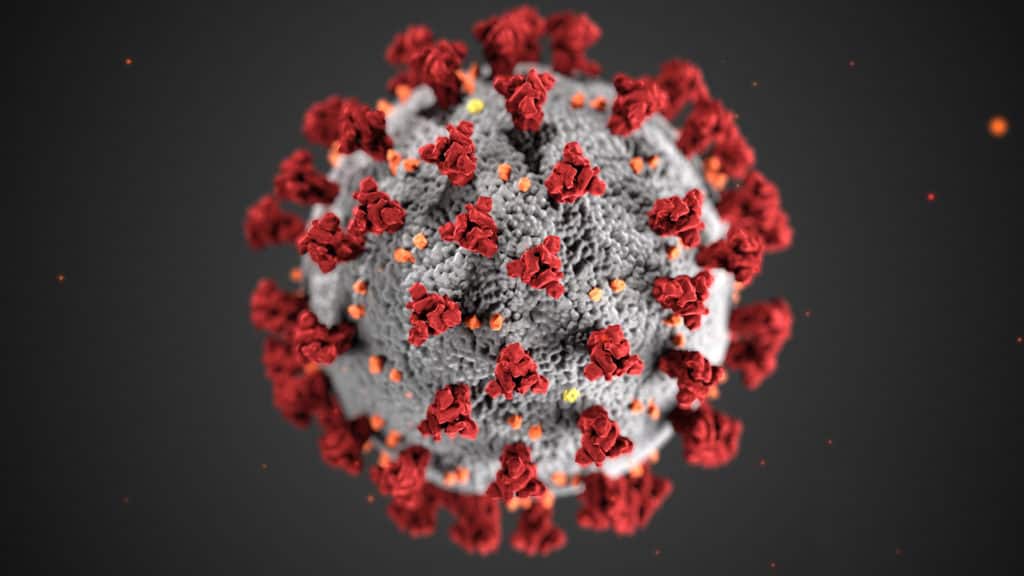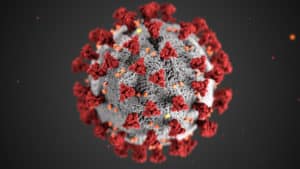Call free on: 0800 389 2839
Call free on: 0800 389 2839
Join in... The latest news and blogs from NEC
How can studying biology help you understand coronavirus? Friday, 22 May 2020

Written by NEC biology tutor Josie Briggs, learn about how studying biology can help during this time.
Trial vaccine for COVID-19 coronavirus
Most people know by now what the virus that causes COVID-19 looks like, with pictures of it every time we watch the news on TV. This tiny pathogen is essentially a sphere with spikes on it.
The spikes are proteins which attach to receptors on a cell surface, after which the viral contents can enter the cell to do their worst. Corona viruses have RNA genomes which, once inside the host cell, act as mRNA to make the viral proteins, using the normal cell mechanism for translation. These new proteins, with other viral components, are then compiled into a large number of new viruses which are released from the dying cell to attack other cells.
 Research into potential antiviral drugs and vaccines focuses mainly on disabling the viral spike proteins so the virus cannot attach to receptors on cell membranes. There are several possible approaches including blocking the spikes so they cannot fit into the receptors, and boosting the immune system to be more effective at making antibodies to the spike proteins and killing the virus. Other approaches involve trying to reduce the inflammation caused by overreaction of the immune system in some patients.
Research into potential antiviral drugs and vaccines focuses mainly on disabling the viral spike proteins so the virus cannot attach to receptors on cell membranes. There are several possible approaches including blocking the spikes so they cannot fit into the receptors, and boosting the immune system to be more effective at making antibodies to the spike proteins and killing the virus. Other approaches involve trying to reduce the inflammation caused by overreaction of the immune system in some patients.
The body’s response to infection is complex and involves several types of cells and other components of the immune system. When a pathogen enters your body, the immune system springs into action, with phagocytes engulfing some of the pathogens and other cells producing antibodies specific to the pathogen. If the pathogen is new to the body, especially if the viral loading is high, the immune system may struggle to cope and the disease takes hold.
Memory cells are produced as part of the response, so that subsequent infections can be dealt with quickly and before symptoms develop. Length of resistance time to coronaviruses varies from months to years, according to the variety of virus, and it is not yet known how long a person will remain resistant to the COVID-19 virus after first infection.
Many groups throughout the world are researching potential vaccines to this virus and at least one is already undergoing clinical trials. Others are being tested in animal studies.
Researchers at Oxford University’s Jenner Institute, collaborating with Oxford Vaccine Group clinical teams, have begun to vaccinate several hundred volunteers, some with the trial vaccine and others with a control injection. Both groups will be monitored for safety and to see if the vaccine leads to an immune response.
Unlike the flu vaccination, which contains viral antigens to stimulate production of antibodies and memory cells, this experimental vaccine uses a harmless adenovirus as a vector to carry genetic material from the coronavirus. Genes for the coronaviruses spike proteins are inserted into the vector virus. On entering the body, these genes enter cells and produce viral spike proteins, some of which are presented on cell surfaces or released outside the cell. These should be recognised as alien antigens by the immune system.
The safety and effectiveness of the trial vaccine are being tested in the Oxford clinical trial. If successful, the next stage clinical trials on a larger scale will begin.
How can NEC help?
IGCSE biology
Section 1 Topic 2 describes the basic structure of viruses and how they can only reproduce by invading cells and taking over the cells’ mechanisms to make new viruses.
Section 2 Topic 3 explains the structure and functions of proteins. The COVID-19 spikes consist of complex proteins that can attach to certain molecules in cell membranes.
Section 8 Topic 1 shows the structure of DNA. Many viruses contain genes made of DNA; others, for example coronaviruses and viruses that cause colds and flu, have genes made of RNA. RNA is similar in structure to DNA, and human cells make and use RNA when producing proteins using the information in our genes.
Section 10 Topic 5 tells how viruses can be used as vectors to carry genes from one organism into cells of a different organism. This technique is used to produce genetically modified organisms. Some research groups making and testing potential vaccines for COVID-19 are using a similar technique, placing some of this virus’s genes inside a harmless virus which can then deliver the genes into patients’ own cells.
A level biology
Section 2 Topic 4 goes into detail about the structures and roles of DNA and RNA, the genetic code, and transcription and translation of genes to produce polypeptide chains which will be processed into proteins. The RNA genome of the COVID-19 virus means that its genes can function as messenger RNA, hence by-passing the transcription stage of protein synthesis.
Section 6 Topics 1 to 5 describe the body’s immune response to infection, using HIV (another RNA genome virus) as an example. Topic 4 explains how different types of vaccine (active and passive) work. Many trial vaccines for COVID-19 are active, in that they are expected to activate the body’s immune system against viral antigens.
One of the questions in Assignment 6 contains information and a flow chart showing how DNA vaccines work. Many trial vaccines are using viral RNA genes (or DNA retro-transcribed from these) to induce patients’ cells to produce viral antigens.
About the author
Josie Briggs is one of our amazing biology tutors, supporting students at both GCSE and A level. She also wrote ‘Why I love Biology’ which you can read here.
How can NEC help?
We have the following biology courses available:
- IGCSE Biology
- A level Biology
- AS Biology
- Structured Fast Track A level Biology (coming soon, register interest to be kept up-to-date)
Looking to get into a specific field? Our free Career Tracks guide is a great place to start: https://www.nec.ac.uk/career-tracks/
References
- Sagar Aryal, ‘Severe Acute Respiratory Syndrome Coronavirus (SARS-CoV)’, https://microbenotes.com/severe-acute-respiratory-syndrome-coronavirus-sars-cov/, 10 February 2018 (accessed 1 May 2020)
- University of Oxford, ‘Oxford COVID-19 vaccine programme opens for clinical trial recruitment’, http://www.ox.ac.uk/news/2020-03-27-oxford-covid-19-vaccine-programme-opens-clinical-trial-recruitment#, 27 March 2020 (accessed 1 May 2020)
Leave a Reply Cancel reply
More stories
working at NEC
Uncategorized
- Balancing an A level with My Passion for Dance
- The Future of Art History: Why Study A level History of Art with the National Extension College?
- Why Study Physics?
- Embracing a New Path: Jill’s Journey from Online Learning to Career Success in Art History
- How Toby Found a Perfect Fit for His Passion: Online A level English Literature with NEC
Study Tips
Student Stories
- Balancing an A level with My Passion for Dance
- Passion and Academics: How Izzy Balances Full-time Musical Theatre Studies with Studying A level Physics
- How NEC Helped Kari’s Son Niko to Continue his A level Studies Despite Long-Term Illness
- Embracing a New Path: Jill’s Journey from Online Learning to Career Success in Art History
- How Toby Found a Perfect Fit for His Passion: Online A level English Literature with NEC
SFT
Results Day
- Resitting A level STEM Subjects: How to Turn Your Setback into a Stepping Stone for a Brighter Future
- Resits vs. Retakes: Understanding the Difference and Making the Most of Your Second Chance
- GCSE Results Day 2024: What to Do When You Didn’t Get the GCSE Results You Wanted
- GCSE Results Day 2024: Your Complete Guide
- A level Results Day 2024: Your Ultimate Guide to Success
Policy and Campaigns
- A Pathway to Success Beyond A levels: Why Level 4 and Level 5 Qualifications Matter
- Schools and Academies Show 2024: Insights for School Leaders
- Big Data and Educational Trends: Insights for Students and Schools
- University of Cambridge Institute of Continuing Education offers tuition fee bursary for NEC A level students
- Five study bursaries for state sector teachers to take online A level Classical Civilisation offered by The Classical Association
Podcast
Our Courses
- Balancing an A level with My Passion for Dance
- How NEC’s Inclusive Approach to Learning Design is Redefining Independent Learning
- NEC’s Learning Design: A Pathway to Success for Independent Learners
- Passion and Academics: How Izzy Balances Full-time Musical Theatre Studies with Studying A level Physics
- Why Study Psychology? – Key Benefits, Careers and What You’ll Need to Study Psychology at University
Lifelong Learning
- A Pathway to Success Beyond A levels: Why Level 4 and Level 5 Qualifications Matter
- Benefits of Homeschooling: Is Home Education Right for Your Family?
- How NEC’s Inclusive Approach to Learning Design is Redefining Independent Learning
- The Future of Art History: Why Study A level History of Art with the National Extension College?
- National Coding Week 2024: The Vital Role of Coding in the Modern World
Home Schooling
- Benefits of Homeschooling: Is Home Education Right for Your Family?
- How NEC Helped Kari’s Son Niko to Continue his A level Studies Despite Long-Term Illness
- Exploring Science Practicals at Home: A Guide for Homeschoolers
- Homeschooling in 2024: How to Personalise Your Child’s Education
- What is Homeschooling?
Guest Blogs
- Passion and Academics: How Izzy Balances Full-time Musical Theatre Studies with Studying A level Physics
- My Experience as a Marketing Intern with the National Extension College
- The economics of political parties
- Embarking on a journey: My decision to ‘Fast-Track’ A level Physics with NEC
- Homeschooler Andrew’s experience of studying IGCSE Chemistry
General
- Balancing an A level with My Passion for Dance
- A Pathway to Success Beyond A levels: Why Level 4 and Level 5 Qualifications Matter
- Schools and Academies Show 2024: Insights for School Leaders
- How NEC’s Inclusive Approach to Learning Design is Redefining Independent Learning
- NEC’s Learning Design: A Pathway to Success for Independent Learners

Add a new comment
Current comments: 0